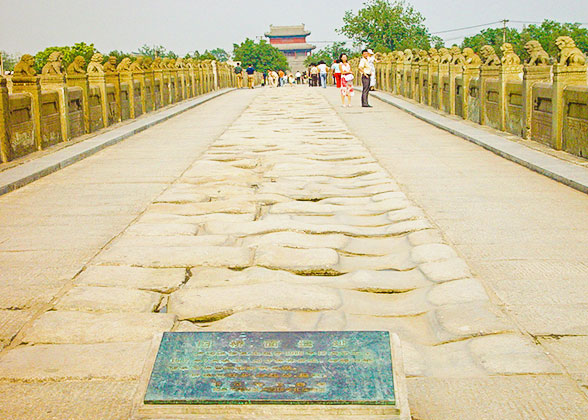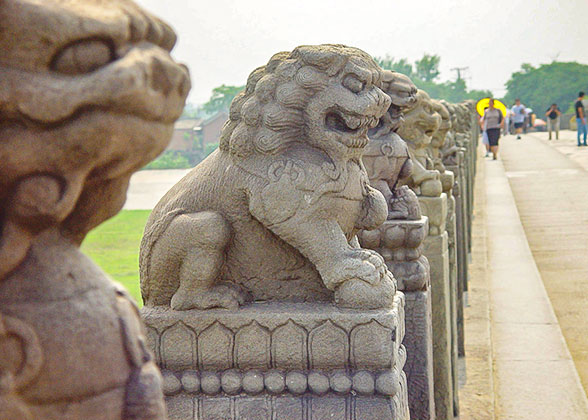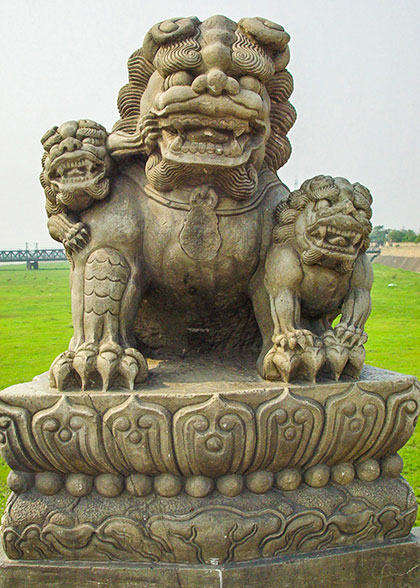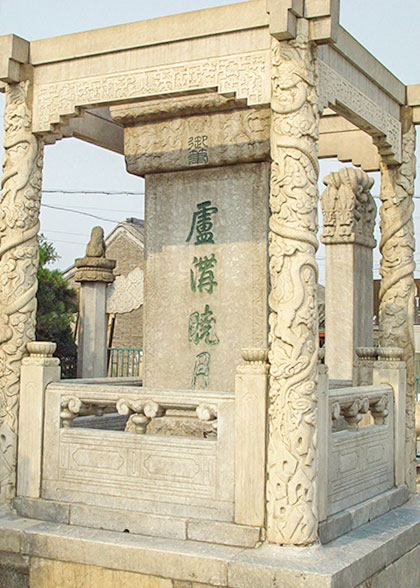Marco Polo Bridge (Lugou Bridge)
Marco Polo Bridge, also known as the Lugou Bridge, is reputed for countless finely carved lions on the railings on both sides. It was described by the famous Italian traveler Marco Polo as a stunning bridge in his book, hence the name. This historic structure that crosses the Yongding River is situated 9 miles (15km) southwest of Tiananmen, the center of Beijing.
 |  |
Construction of the original bridge on this site commenced in 1189 and was completed in 1192 and was later reconstructed in 1698. It is 874 feet (266.5m) in length and 30.5 feet (9.3m) in width, supported on 281 pillars. On each pillar stands a stone lion. The most intriguing feature of these beasts is the fact that there are more lions hiding on the head, back or under the belly or on paws of each big lion. Investigations to determine the total number of animals have been carried out on several occasions but the results have proved inconsistent, ranging from 482 to 496. However, record has it that there were originally a total of 627 lions. The posture of each lion varies, so do their ages. Most date from the Ming (1368-1644) and Qing (1644-1911) dynasties, some are from the earlier Yuan Dynasty (1271-1368); while the few lions dating back to as long as the Jin Dynasty (1115-1234) are now quite rare.  Four ornamental columns each 15 feet (4.65 meters) high and a white marble stele stand at the ends of the bridge. One stele records the reconstruction of the bridge by Emperor Kangxi of the Qing Dynasty (1644-1911) in 1698. The other stele bears calligraphy by Emperor Qianlong, the grandson of Kangxi. It reads 'Morning moon over Lugou', and for the 700 years since its completion, the bridge has been a well known scenic spot in the city.
Four ornamental columns each 15 feet (4.65 meters) high and a white marble stele stand at the ends of the bridge. One stele records the reconstruction of the bridge by Emperor Kangxi of the Qing Dynasty (1644-1911) in 1698. The other stele bears calligraphy by Emperor Qianlong, the grandson of Kangxi. It reads 'Morning moon over Lugou', and for the 700 years since its completion, the bridge has been a well known scenic spot in the city.
Not only famed for its aesthetic features, the Marco Polo Bridge is also considered to be an architectural masterpiece. It is built of solid granite, with a large central arch flanked by ten smaller ones. Each of the ten piers is protected by triangular iron pillars that have been installed to prevent flood and ice.
Marco Polo Bridge Incident
How to get to Marco Polo Bridge

1. Take bus 309, 329, 339, 458, 459, 624, 661, 662 or 952 and get off at Lugou Xinqiao Station.
2. Take bus 77, 96, 97, 133, 310, 313, 452, 843, 896, 983, or Fast Transit Line 45, 97, 145, or Special Line 17 and get off at Kangzhan Diaosuyuan (Sculpture Garden) Station.
Take Subway Line 14 and get off at Dawayao Station. Get out from Exit D. Then take bus 339 at Xidaokou Bei Station and get off at Lugou Xinqiao Station.
Beijing Bus / Subway Search
Admission Fee
Opening Hours
Wanping City Wall (Admission fee: CNY 3)
Sculpture Garden (free of charge and open during 08:00 - 17:00, closed on Monday)
Lugou Bridge History Museum
Beijing One Day Tour: Sino-Japanese War Sculpture Garden - Wanping City - Marco Polo Bridge
More Beijing Tours